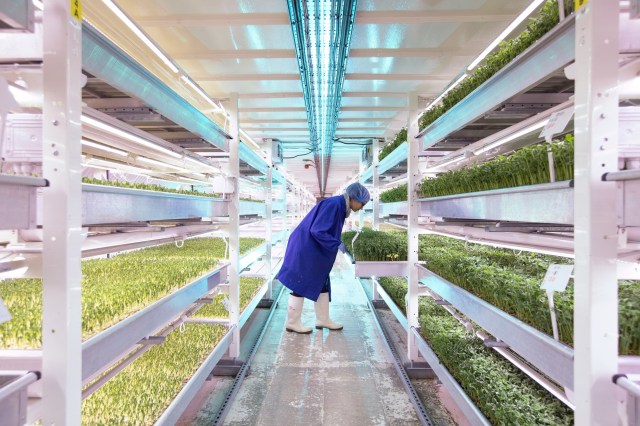Credit: Dan Kitwood/Getty Images

Do you grow your own?
Vegetables, I mean. If you do and you’re any good at it, you’ll know that homegrown produce can be much tastier than supermarket fare. And yet most gardeners, however keen, would starve if they had to rely exclusively on their own harvest. Even if they could grow and preserve enough veg for the whole year, there’s a basic calorie problem.
Fresh green produce is packed with fibre and vitamins, but when it comes to energy, lettuce etc lets us down. To get enough calories to sustain life, human societies rely on starchy, sugar-laden or oil-bearing crops and/or animal products. Since the invention of farming, ten thousand years ago, we’ve been especially dependent on cereal and root crops.
Now hold on to that thought, because today’s topic is the potential of a radically new form of agriculture to feed the planet.
The idea is that we’ll be farming much, or even most, of our food indoors rather than out. Our cities will feature high-rise ‘vertical farms’ in which crops grow hydroponically under artificial lights, with the animals we eat reared intensively under the same roof – their waste products helping to fertilise the crops (some of which are used to feed the animals).
As Stephen Davies points out, in an eye opening piece for the American Institute for Economic Research, there would be many advantages:
“Because the crops can be grown very close to the point of final sale (maybe attached to a grocery store), the transport costs and associated impacts are enormously reduced while the food is much fresher. It is also of higher and more consistent quality, and because it is grown in a controlled environment there is far less of a problem with pests. This means you do not have to use large quantities of herbicide and pesticide outdoors, where it inevitably enters the wider environment…”
Unfortunately, there are some pretty fundamental problems too:
“The major challenge has always been the very high levels of energy that vertical farming with artificial lighting and heating requires. In 2016, vertically farmed lettuce used 14 times more energy than lettuce grown in a conventional heated greenhouse.”
However, the increasing efficiency of LED lighting could mean that the hydroponic vertical farming does become viable. Artificial light will always be more expensive than the free and natural version, but if the extra cost is low enough it can be offset by the benefits:
“Because the crops can be grown all year round, you can have six to seven crops a year instead of two or three, so output is higher and spread throughout the year.”
But this is where the calorie problem comes in. The hardest crops to grow hydroponically are those energy-rich cereal and root crops. But perhaps we won’t need these so much in future. After all, this is the age of the low carb diet – indeed of the ‘paleo’ diet from which the starchy, sugary foods of the first agricultural revolution have been banished. If this trend continues then vertical farming might be able to feed the cities. Irrespective of dietary fashion, our sedentary, centrally-heated, urban lifestyles don’t require us to burn as many calories as in the past.
Sounds promising, but there’s a problem with the meaty side of urban agriculture. The other great dietary trend of our era – veganism – is evidence of a growing disquiet with the way we treat animals. It’s difficult to see how vertical farms help with the welfare issues surrounding intensive meat production. Indeed, the urban context brings the horror closer to home.
However, once again, technology is coming to the rescue. Stephen Davies says that the cost of producing vat-grown or ‘cultured’ meat has come down so far that it now poses a threat to conventional livestock farming:
“There are two indicators that cultured meat is on the verge of a major commercial breakthrough. The first is the amount of capital now being invested in it. The other, even more revealing, is that organized interests such as cattlemen are now lobbying against it and looking to use legislation and regulation to block it.”
There’s a parallel here to the energy sector. Ten years ago, there was an intense debate about the role of renewable power. Investors were getting behind wind and solar in a big way – stirring up a major lobbying effort to persuade governments to stick with fossil fuels and nuclear power. I’m glad to say that that the innovators won and the lobbyists lost. Today, renewable energy is the fastest growing source of new generating capacity because it’s the most competitive.
If the same dynamics are lining up behind a combination of vertical farms and cultured meat then we can expect massive disruption in the agricultural sector too.
The prize is a sustainable and cruelty-free intensification of food production – allowing us to free-up and re-wild great swathes of farmland. I don’t suppose we’ll entirely eliminate carbs from our diet, but we can eliminate cereal-fed animals from our diet – and, by extension, the land required for the livestock plus that required for growing their feed.
Given the accumulating evidence of widespread ecological collapse, any opportunity to reduce our environmental footprint can’t come too soon.










Join the discussion
Join like minded readers that support our journalism by becoming a paid subscriber
To join the discussion in the comments, become a paid subscriber.
Join like minded readers that support our journalism, read unlimited articles and enjoy other subscriber-only benefits.
Subscribe